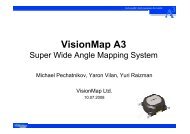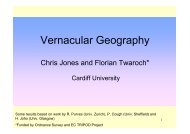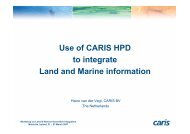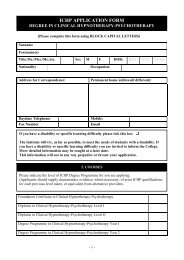EuroSDR Projects - Host Ireland
EuroSDR Projects - Host Ireland
EuroSDR Projects - Host Ireland
You also want an ePaper? Increase the reach of your titles
YUMPU automatically turns print PDFs into web optimized ePapers that Google loves.
Finally, we want to note some important overall findings:<br />
• The approaches based on line extraction, i.e., Bacher, Gerke_W, Gerke_WB and Hedman based on<br />
the Steger extractor as well as Beumier built on top of Lacroix's work give better results for the<br />
more line-like high resolution Ikonos data than approaches based on pixel-wise or local<br />
classification, i.e., Zhang and Malpica. It would be interesting to see how the latter perform on<br />
higher resolution aerial images where the line structure of the image is less marked and the<br />
spectral information should be of higher quality. Please note that the Ikonos data are pansharpened<br />
with a physical resolution for the color of only 4 m. One issue still to be investigated is<br />
the use of the original low resolution images.<br />
• There is a trend to use color / multispectral information particularly for high resolution satellite<br />
data. This is done either as simple as the NDVI (Beumier and Hedman) or based on a more or less<br />
sophisticated classification (Bacher, Malpica, and Zhang). For the latter, training is done using<br />
given GIS data (Malpica), training areas are automatically generated from characteristic<br />
homogeneous road parts with parallel road sides (Bacher), or the classification is done<br />
unsupervised (Zhang).<br />
• Network optimization and bridging gaps, e.g., by means of snakes, only seems to become<br />
important when a certain level of quality has been reached as, for example, by Bacher for<br />
Ikonos_Sub1 and 2.<br />
In summary, the results show that it is possible to extract roads with a quality in terms of<br />
completeness and correctness which should be useful for practical applications, although only for<br />
scenes with limited complexity, namely up to medium complex rural scenes. This is true for aerial as<br />
well as high resolution satellite data. The test has also demonstrated that most approaches cannot deal<br />
with images larger than about 2,000 by 2,000 pixels at the moment. This is probably due to missing<br />
functionality to process images in patches and shows that the approaches focus on furthering the<br />
understanding of the basic problems rather than on practical development, where robustness to all<br />
possible situations would be the central issue.<br />
With the advent of digital aerial cameras and high resolution satellite data making high quality color<br />
and spectral information available, there is a recent focus in research on road extraction to employ this<br />
information and the results show its usefulness. However, particularly for the high resolution data<br />
such as from the ADS40, there is still much to be done, e.g., by making use of the link to the typical<br />
materials used to construct roads or by employing line-finders that make full use of color information.<br />
Additional remarks: One of the reviewers of this report suggested a cross-analysis of the data, i.e.,<br />
results of the extraction. The idea would be to analyze in detail where the approaches produce the<br />
same or similar results and where and how they differ, to find complementary strengths. We had this<br />
in mind when starting the test, but finally decided not to analyze the data on this level. The main<br />
reason for this is that from what we know the different groups put very different effort into generating<br />
the data. Thus, while the data can be used for an overview, we think that analyzing it in depth would<br />
lead to an over-interpretation. To still give the possibility for a more in-depth analysis, we have<br />
published all data visually on our web-page.<br />
6 Conclusions and Recommendations<br />
The original proposal of the working group was much more focused on practical aspects. We not only<br />
wanted to make available a priori data to be used in the test, but also wanted to test semi-automated<br />
237









